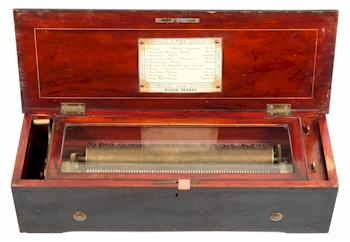
A standard 19th century Swiss musical box.
The musical box appeared around 1800 and evolved from clocks with chiming bells and gongs - little wonder that the main music box industry was based in Switzerland.
Musical boxes were divided by their movements, all of which were driven by spring mechanisms. There was the Barrilet movement, the Sur-plateau movement and finally the most common movement, the cylinder movement. The cylinder would have tiny pins in it and would flick against a comb with different length teeth producing different musical notes. By placing the pins in the correct order and timing, a tune was produced. Combined with this, some musical boxes had extra instruments such as drums and bells, which were often struck by hammers in the form of bees or butterflies.

A typical musical box with tune indicator.
Fitted in attractive cases of walnut, rosewood or satin wood they came in various sizes, some for use on the table top others with their own stands, which often included drawers containing extra cylinders. The movement originally would have been key wound but this was later replaced with a ratchet lever. They would play anything from four to twelve airs on one cylinder. They were capable of repeating the same song over and over or passing on to the next air. To help the owner, some musical boxes were fitted with a tune indicator showing which air was playing. Also, there would be a song chart applied to the inside of the lid.

A double wound musical box with tune indicators.
One of the most important makers of musical boxes was Nicole Freres of Geneva who exported their boxes worldwide. However, the popularity of musical boxes declined through the later part of the 19th Century and, like any music system, they were superseded by the disc musical box. The discs were easier and cheaper to produce than the time consuming cylinders. Certain examples of disc musical boxes were installed in pubs and were coin operated; yes, an early form of juke box! To bring the tale full circle, some disc musical boxes were incorporated within clocks. The popularity of these "penny-in-the-slot" machines declined after the First World War.

A musical box movement with bells-in-sight action.

A substantial Nicole Freres musical box.
Prices for cylinder musical boxes can vary widely from as little as a couple of hundred pounds to thousands of pounds depending on their maker and how complicated their mechanism is, how many cylinders there are and of course the condition of the musical box itself.

A table top disc musical box.
- Bearnes Hampton & Littlewood
- Musical Boxes
Musical Boxes was written on Friday, 22nd November 2019.










